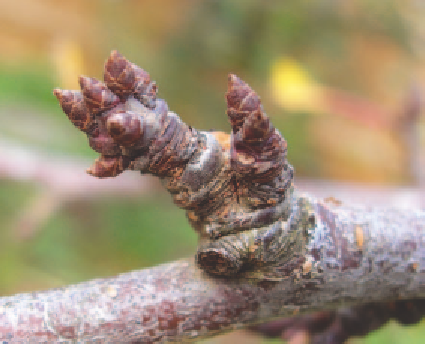Agriculture Reference
In-Depth Information
preferable. The combination of dry weather
and active growth are the best defense against
infection, therefore pruning before netting is
not only convenient (trees are easier to net),
but is the most efficacious. A spray program
of Bordeaux mixture at leaf fall and again at
bud burst should control fungal infections.
Whenever you prune, always disinfect your
secateurs with methylated spirits
at every cut
to
prevent spreading disease from one part of the plant
to another.
Maintenancepruning
As usual, all crossed and crowded wood
should be removed and over-long side
growths shortened. Strong vertical growth
usually has the addition of a whorl of sprigs
about halfway down the shoot. It is tempting
to cut just above these so they develop into
fruiting wood. Don't be tempted. Cut below
the whorl of growth and you will be rewarded
with fruiting side growth much closer to the
major branch (see Figure 6.10).
Figure 6.9
Apricots fruit on small side growths and spurs
developed on one- to three-year-old wood.
The spurs are made up of a mass of flower
buds, often with a wood bud behind the
terminal flower bud. The wood bud/shoot
keeps the spur growing strongly, and can be
shortened back by a third in mid to late
summer so that more spurs develop. Apricots
are generally self-pollinating so only one tree
is needed for fruit, though some cultivars
need cross-pollination. Check with your
nursery. Either way another tree in the
vicinity can improve fruit set.
Any diseased wood should be pruned out as
soon as you see it, making sure that the
secateurs are disinfected before and after.
Aim to thin shoots lightly and remove smaller
branches to renew fruiting wood and keep
the canopy open to sunlight and air. Cut to a
downward- and outward-facing bud to keep
the growth low and away from the centre of
the tree.
Pruningtime
Due to the apricot's susceptibility to
gummosis and other fungal diseases, pruning
time can be critical. Many authorities insist
that pruning in mid winter when the
populations of fungal spores are low is the
best time to avoid infection through pruning;
however, it is also damp weather when the
tree is dormant and cannot heal itself quickly.
Late summer and early autumn pruning,
when the tree is actively growing, is
Unprunedtrees
Apricots can be successfully left unpruned
apart from initial pruning at planting (see
pages 129-130). The resulting tree will, of
course, be large and may take longer to fruit.

